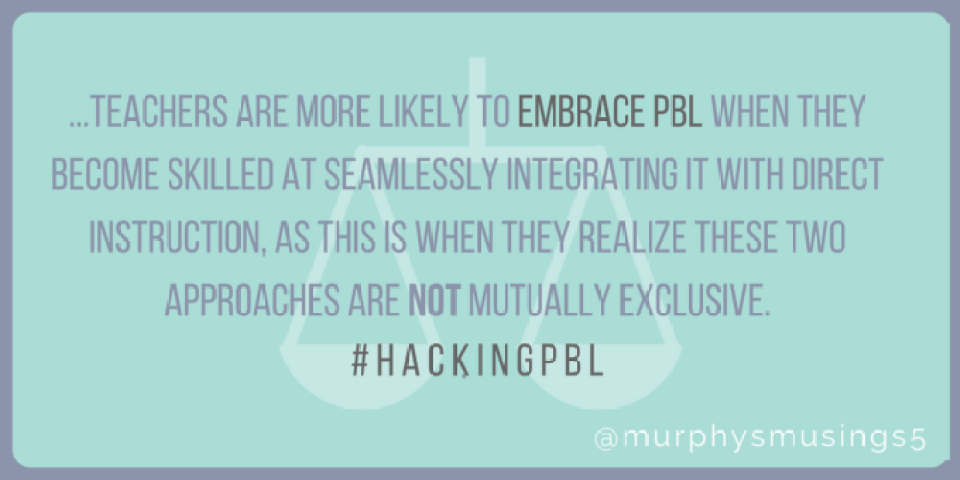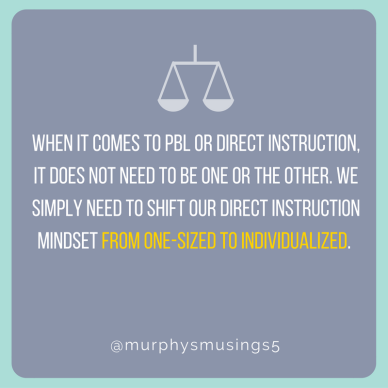The Five Ws of Direct Instruction During PBL #HackingPBL
Over the next month I will be publishing 5 posts as sneak peaks for our upcoming book, Hacking Project Based Learning, which was written with Ross Cooper (@rosscoops31) and will be released this winter.
During a recent chat, a teacher shared his hesitance to approach Project Based Learning (PBL) or inquiry-based learning stems from his belief that some information requires direct instruction. This disclosure stood out to me, as I never thought of PBL and direct instruction as a one or the other option. To the contrary, strategic, differentiated instruction is critical to student success. I have found, teachers are more likely to embrace PBL when they become skilled at seamlessly integrating it with direct instruction, as this is when they realize these two approaches are not mutually exclusive.

Here is what I take into consideration when infusing PBL with direct instruction.
Who
A major misnomer regarding direct instruction is that it is always intended for for the whole group. There are times when providing direction instruction to your class as a whole would make sense. For example, the introduction of a new concept or idea lends itself to a whole group exploration or discussion. If you are outlining a steps in a procedure, it would make sense to explain that to everyone at one time. However, more often, direct instruction is best implemented through a differentiated approach: providing a lesson to a student or group of students based on an identified need. This need is typically determined through a formative assessment – conferencing, written reflection, homework assignment, etc.
What
The word “mini-lesson” is commonly used to describe brief sessions of targeted direct instruction. Mini-lessons have a clear objective, involve the teacher modeling a concept, skill, or strategy, and typically last approximately 10 – 20 minutes. We determine the focus of mini-lesson based on curriculum requirements, but most importantly, student need. Through regular conferencing and formative assessment (aligned to the learning objectives for your project), you will determine what content may need to be retaught or provided in a different way. During a PBL or inquiry-based experience, it may be necessary to plan mini-lessons to address the content you feel students will not naturally uncover through exploration.
Where
I find it extremely beneficial to create a special place or seating arrangement for mini-lessons. Using this change of scenery adds to your overall classroom culture and signals to students that something new is coming. Depending on your classroom size, or perhaps the age of your class, you may choose to bring your students to a carpeted area on the floor. (Please do not assume that students in high school are too old to sit on the floor.) If your room does not have a carpeted area, perhaps students can sit on their desks or move their chairs into an alternate formation. For small group instruction, a table or cluster of desks works well. The needs of your students and/or lesson to dictate the formation of your classroom.
When
Timing is highly dependent on the “who” and the “what” of your lesson. When approaching a unit, whole group lessons should be integrated when the majority of the class is ready for a new stimulus. You may need to introduce a new concept or refine an idea students are already exploring. In regards to your daily approach, many times teachers feel that it makes the most sense to start the class period with a mini-lesson. I actually disagree. I find that allowing students to enter the class and immediately begin engaging in their work is far more effective. About half-way through the period, ask the students to pause for the mini-lesson. Ideally, the students would have time after the lesson to get back into their work, but if they do not, then they will start the next day with this new information.
Why
As with most things, the why is probably the most important. Being intentional about direct instruction is critical to building a learning culture in your classroom. If a classroom is all direct instruction all the time, all content seems equally important and it is nearly impossible for students to filter through and make meaning from 45 minutes of lecture, even if they have a study guide. When we use direct instruction strategically, our input is taken much more seriously. The mini-lesson model means we are providing students  content in bite sized pieces, which are much easier to synthesize and explore. In addition, integrating direction instruction using an “as needed” approach allows us to scaffolded our support as students attempt to understand abstract concepts. We can gradually increase or decrease our instruction based on student need.
content in bite sized pieces, which are much easier to synthesize and explore. In addition, integrating direction instruction using an “as needed” approach allows us to scaffolded our support as students attempt to understand abstract concepts. We can gradually increase or decrease our instruction based on student need.
When it comes to PBL or direct instruction, it does not need to be one or the other. We simply need to shift our direct instruction mindset from one-sized to individualized.
How do you ensure direct instruction is best meeting your students needs?



